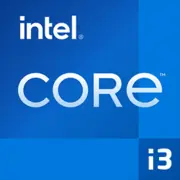Intel Core i3-1215U

Intel Core i3-1215U: 現代のウルトラブックに最適なパフォーマンスとバッテリー寿命のバランス
2025年3月
アーキテクチャと製造プロセス: 効率のためのハイブリッドアプローチ
Intel Core i3-1215Uプロセッサは、Alder Lakeシリーズの一環としてリリースされ、予算内ウルトラブックやエントリーノートパソコンの重要なソリューションの一つとなっています。これのアーキテクチャは、パフォーマンスコア(Pコア)とエネルギー効率の高いコア(Eコア)を組み合わせたハイブリッド設計に基づいています:
- 6コア(2 Pコア + 4 Eコア)及び8スレッド(Pコアはハイパースレッディングをサポート)。
- Pコアは基本周波数1.2GHz、ターボブーストで最大4.4GHz、Eコアは最大3.3GHzで動作。
- 10MBのL3キャッシュは、マルチタスクのためのデータへの迅速なアクセスを提供します。
Intel 7製造プロセス(以前の10nm Enhanced SuperFinとして知られる)は、エネルギー消費を削減し、トランジスタ密度を向上させます。Intel UHD Graphics 12世代(64 EU、周波数最大1.1GHz)は4Kディスプレイをサポートし、AV1デコーディングにも対応しており、ストリーミングに最適です。
エネルギー消費とTDP: 薄型デバイス向けの15W
このプロセッサのTDPは15Wであり、ウルトラブックに一般的です。ノートパソコン製造メーカーは、この値を調整(例えば、"Turbo"モードで25Wに引き上げることなど)でき、これがパフォーマンスや熱に影響を与えます。
- 標準的なシナリオ(ブラウザ作業、オフィスタスク)では、チップは5-8Wの消費で、バッテリー寿命を延ばします。
- 負荷時(動画レンダリング、ゲーム)には、消費電力が25Wに達する場合がありますが、薄型筐体内の冷却システムは、その値を長時間維持するのにしばしば不十分です。
パフォーマンス: オフィスから軽いゲームまで
Geekbench 6は、i3-1215Uのシングルスレッドタスクでの強さを示しています:
- 1842ポイント(シングルコア) — 過去のトッププロセッサ(例えばIntel Core i7-1165G7)に近いレベル。
- 4817ポイント(マルチコア) — Pコアの数が限られているため控えめですが、基本的なマルチタスクには十分です。
実際のシナリオ:
- オフィスと学習: Chromeで20以上のタブ、Wordドキュメント、Zoomを同時に開いてもラグなし。
- マルチメディア: 4K動画はVLCやYouTubeでスムーズに再生でき、DaVinci Resolveでの編集も可能ですが制限があります(1080pまでの動画)。
- ゲーム: Dota 2やCS:GOは720pの低設定で30-45 FPS。フォートナイトは480pに解像度を下げる必要があります。
Turboモードは重いアプリケーションを開く短いスパイクでは効果的に動作しますが、長時間の負荷でPコア周波数は2.8-3.2GHzに低下します。
使用シナリオ: i3-1215Uは誰に適しているか?
- 学生やオフィスワーカー — ドキュメント作成、オンラインコース、ビデオ通話用。
- モビリティを重視するユーザー — 重量1.2kg以上の軽量ノートパソコンで、バッテリー寿命8-10時間。
- バジェット購入者 — このCPUを搭載したデバイスは$450-700(例えば、Acer Swift 3やLenovo IdeaPad 5)で入手可能。
不適合:
- ゲーマー — 現代のAAAゲームには統合グラフィックスが不十分。
- ビデオ編集者やエンジニア — 4Kレンダリングには6コアは不足。
バッテリー寿命: 穏やかなモードで最大10時間
50-60W·hのバッテリー容量を持つノートパソコンは、i3-1215Uで次の結果を示します:
- テキスト作業やサーフィン時に8-10時間(輝度50%、Wi-Fiがアクティブ)。
- YouTubeやZoomの視聴時に4-5時間。
省エネルギー技術:
- Intel Dynamic Tuning 3.0 — 負荷に応じて電力を適応的に調整。
- AV1デコーディング — ストリーミングのエネルギー消費を削減。
アドバイス: Windowsの設定でTurbo Boostをオフにすると、バッテリー寿命が15-20%向上します。
競合製品との比較: AMD、Apple、そして過去の世代
- AMD Ryzen 5 7520U(Zen 2、4コア/8スレッド): シングルスレッドタスクでは劣る(Geekbench 6で約1600点)、しかしマルチスレッドでは優れている(5000+ポイント)。価格は同様。
- Apple M1(2020): i3-1215Uよりもエネルギー効率とマルチタスク能力が優れていますが、macOSに制限され、価格も高い($700以上)。
- Intel Core i5-1135G7(2020): シングルスレッドパフォーマンスで劣ります(約1400ポイント)し、DDR5をサポートしていません。
長所と短所
強み:
- 自身の価格帯での高いシングルスレッドパフォーマンス。
- DDR5-4800およびPCIe 4.0(SSDは最大3.5GB/s)のサポート。
- 現代的なコーデック(AV1、VP9)。
弱み:
- わずか2つのPコア — 重いマルチスレッド時にボトルネック。
- UHDグラフィックスはAMD Radeon 660MやApple M1 GPUより劣る。
- コンパクトな筐体でのTDPの余裕が限られています。
ノートパソコン選びのアドバイス
1. デバイスタイプ: ウルトラブックまたはバジェットノートパソコン。
2. ディスプレイ: 1080pのIPSパネルとアンチグレアコーティング。
3. RAM: 最低8GBのDDR5(できれば16GB)。
4. ストレージ: 512GB NVMe(PCIe 4.0)SSD。
5. ポート: モニター接続のためのThunderbolt 4対応USB-C。
2025年のモデル例:
- HP Pavilion Aero 13($599): 13.3インチ2.5K、16GB DDR5、512GB SSD。
- ASUS Vivobook S14($649): OLEDディスプレイ、M.2 SSDスロット。
最終結論
Intel Core i3-1215Uは、パフォーマンスに一定の余裕を持つ手頃な価格のノートパソコンを探している人にとって良い選択です。オフィス作業、軽いクリエイティブ作業、ストリーミングには適しているものの、プロフェッショナルな負荷には不向きです。主な利点はエネルギー効率、現代のスタンダードのサポート、そして手頃な価格です。もし予算が$500-700であり、macOSが優先されない場合、このプロセッサは日常的なタスクの信頼性のある基盤となるでしょう。
基本
CPUの仕様
メモリ仕様
GPUの仕様
その他
ベンチマーク
他のCPUとの比較
ソーシャルメディアで共有する
または当サイトへのリンクを追加
<a href="https://cputronic.com/ja/cpu/intel-core-i3-1215u" target="_blank">Intel Core i3-1215U</a>